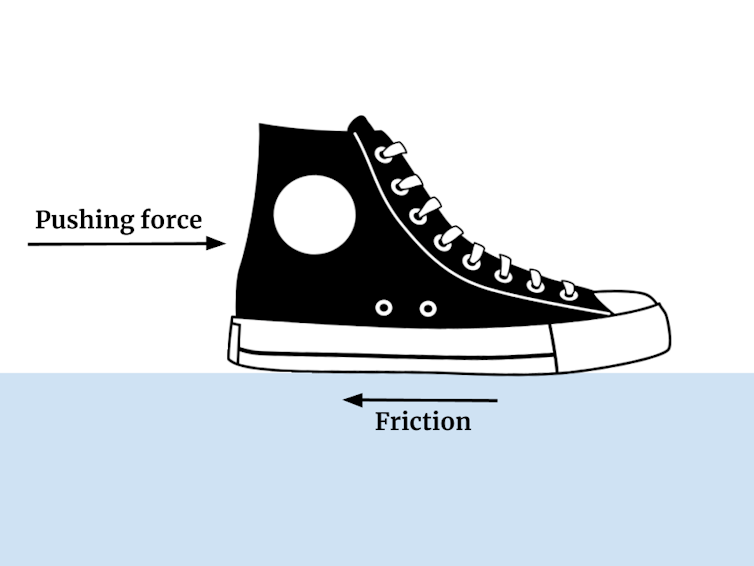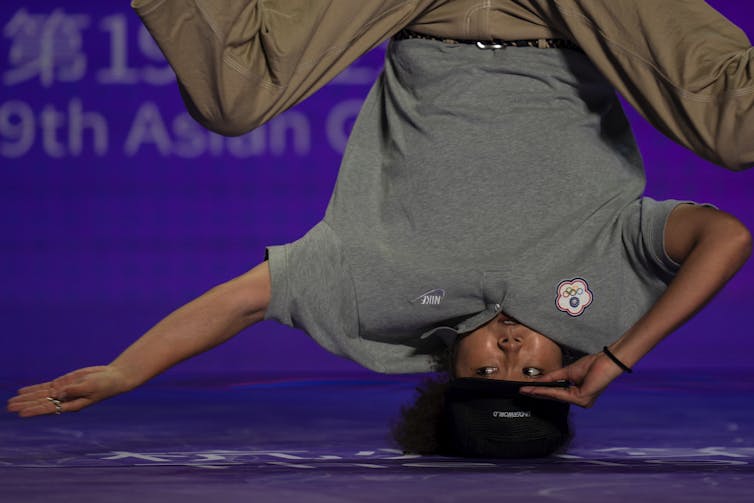
AP Photo/Andres Kudacki
Two athletes square off for an intense dance battle. The DJ starts spinning tunes, and the athletes begin twisting, spinning and seemingly defying gravity, respectfully watching each other and taking turns showing off their skill.
The athletes converse through their movements, speaking through a dance that celebrates both athleticism and creativity. While the athletes probably aren’t consciously thinking about the physics behind their movements, these complex and mesmerizing dances demonstrate a variety of different scientific principles.
Breaking, also known as breakdancing, originated in the late 1970s in the New York City borough of the Bronx. Debuting as an Olympic sport in the 2024 Summer Olympics, breaking will showcase its dynamic moves on a global stage. This urban dance style combines hip-hop culture, acrobatic moves and expressive footwork.
Since its inception, breaking has evolved into a competitive art form. An MC narrates the movements, while a DJ mixes songs to create a dynamic atmosphere. The Olympics will feature two events: one for men, called B-boys, and one for women, called B-girls. In these events, athletes will face off in dance battles.
Athletes earn points for creativity, personality, technique, variety, performativity and musicality. Success in this sport requires combining dance moves from three basic categories: top rock, down rock and freeze.
Standing moves
Top rock moves are performed while standing up, focusing on fancy footwork and hand movements. These movements are reminiscent of hip-hop dancing.
Top rock moves rely on having lots of friction between an athlete’s shoes and the floor. Friction is the force that resists when you slide something across a surface.

The Conversation
This friction allows the athlete to take very quick steps and to stop abruptly. The dancers must intuitively understand inertia, or the fact that their bodies will continue in the direction they’re moving unless they are acted upon by an external force. To stop abruptly, athletes need to engage their muscles, getting their shoes to grip the ground to stop themselves from continuing forward.
Floor moves
Down rock moves are performed while on the floor. Athletes may spin in circles with their head, back, elbows or shoulders touching the ground and their feet in the air. B-boys and B-girls rely heavily on an internal knowledge of physics to complete these moves.
Consider the physics of a backspin. A backspin occurs when the athlete is on their back with their feet lifted in the air, rotating around a specific area of their back.
Sitting on the floor, the athlete’s left foot stays in contact with the floor while they spread their right leg wide, gathering linear momentum as they sweep their right leg toward their left foot in a wide arc. Then, they release their left leg from contact with the ground and roll onto their back.
Now that only their back is in contact with the ground, the linear momentum from their leg turns into angular momentum, which rotates the athlete around an axis that extends upward from their back’s contact point with the ground. This move turns magical when they bring their legs and arms inward, toward the axis of rotation. This principal is called conservation of angular momentum.
When an athlete brings their mass in more closely to the axis of rotation, the athlete’s rotations speed up. Extending their legs and arms once again and moving their mass away from the axis of rotation will cause the competitor to slow their rotation speed down. Once they slow down, they can transition to another move.
Stopping in a pose
Freeze occurs when athletes come to a stop in a funky pose, often occurring in time to the music and in an upside-down position. To freeze effectively, the athlete must have full control over their center of mass, placing it right above the point of their body that is in contact with the floor. The center of mass is the average position of all the parts of an athlete, weighted according to their masses. The “balance point” where the entire mass of the athlete seems to be concentrated is the center of mass.
Athletes are most stable when their center of mass is as close to the ground as possible. You will see many competitors freeze with arms bent in an effort to lower their center of mass. This lowered center of mass reduces their distance from the floor and minimizes the tendency of their body to rock to one side or the other due to torque.

Halfdark/fStop via Getty Images
Torque is a twisting force, like the force used to turn a wrench. The torque depends on two things: the amount of force you apply, and how far from the pivot point you apply the force. With an athlete’s center of mass closer to the ground, the athlete decreases the distance between the pivot point – the ground – and where the force of gravity is applied – the athlete’s center of mass.
Athletes need great strength to halt their motion mid-movement because they have to apply a force to resist the change in inertia.
Finding the right outfit
Many sports require a specific uniform. Breaking doesn’t – an athlete can wear whatever they want – but the right outfit will maximize their chance of success.
The athlete wants a shirt that minimizes the friction between their body and the ground during a spin. Lettering or images on the back of the shirt will add friction, which hinders an athlete’s ability to perform some down rock moves. An athlete may choose to wear long sleeves if they plan to slide on their elbows, as bare skin in contact with the floor provides more friction.
Athletes also have to think about the headgear they wear. While there are many different styles of hats made specifically for breaking, the athlete gets to choose whichever fits their dancing style best. They need to make sure that their hat provides some padding for their head while minimizing the friction between their head and the floor.

AP Photo/Louise Delmotte
The back, elbow and head are axes of rotation during down rock, so the athlete wants gear that minimizes friction at all these places. But they also need to make sure their shoes have grip to maximize friction while they’re doing top rock footwork. Athletes also want to make sure their hands aren’t sweaty or slick so they can use friction from their hands to control how fast they’re rotating during down rock spins.
In the world of breaking – where dancers seem to defy gravity – strength and artistry work hand in hand with physics to create the moves that will captivate audiences during the 2024 Olympics.
Amy Pope, Principal Lecturer of Physics and Astronomy, Clemson University
This article is republished from The Conversation under a Creative Commons license. Read the original article.































































